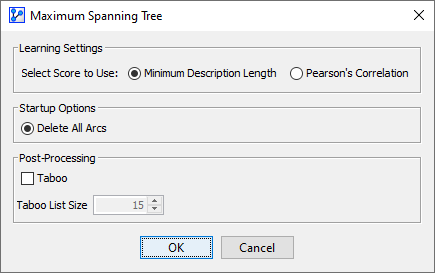Maximum Weight Spanning Tree
Context
- The Maximum Weight Spanning Tree learning algorithm is by far the quickest Unsupervised Structural Learning Algorithm. It only relies on two passes:
- The first pass consists of computing the a priori weight of all binary relationships between all variables.
- The second pass constructs the Maximum Weight Spanning Tree of those relationships.
- While the resulting network may not be optimal, it can be useful for an initial imputation of values as part of a Missing Values Processing strategy.
- The Maximum Weight Spanning Tree learning algorithm can be used as a first network prior to using the Taboo or EQ algorithms.
- Furthermore, it is a practical basis for performing Variable Clustering.
- Internally, the Maximum Weight Spanning Tree initially produces an undirected network. To obtain a directed Bayesian network, BayesiaLab orients the arcs so that V-structures are avoided. However, the presence of Fixed Arcs can lead to the introduction of V-structures.
- The following conditions apply to the Maximum Weight Spanning Tree:
- Fixed Arcs are not protected from deletion.
- Any constraints defined through Forbidden Arcs are respected.
- Temporal Indices are taken into account.
We use the terms Maximum Spanning Tree and Maximum Weight Spanning Tree interchangeably. Both refer to the same learning algorithm.
Usage
-
Select
Menu > Learning > Unsupervised Structural Learning > Maximum Spanning Tree. -
A new window prompts you to specify the learning settings:

-
For this learning algorithm only, you have a choice between two scoring methods, i.e.,
- Minimum Description Length Score.
- Pearson’s Correlation
-
Checking the Taboo box in the Post-Processing panel launches a Taboo search of the specified Taboo List Size in an attempt to improve the network beyond the initial solution found by the Maximum Weight Spanning Tree.
-
The principle of the Taboo search is to permit the score to deteriorate, which is normally “taboo”, with the objective of finding a better solution beyond the immediate local optimum.
